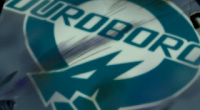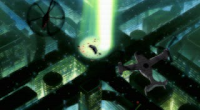Introduction
The Ghost in the Shell movie, released in 1995, is based on the manga of the same by Shirow Masamune and was directed by Mamoru Oshii. Its plot is set in 2029 A.D. in Hong Kong and revolves around a manhunt for a famous hacker known only as The Puppetmaster. Major Motoko Kusanagi, of the counter-terrorism unit Section 9, is tasked with finding him or her and bringing them to justice.Staff, designs and animation
The fact that Production I.G was in charge of producing the animation for AC3 is well known and was part of its marketing campaign in Japan. This would be the fourth collaboration between Namco and Production I.G, after two 'Tales" games and Tekken 3, and the thirteenth game that they would work on after entering the video-game arena with the Ghost in the Shell game for the PSX in 1996.Other studios that Production I.G employed for the animation in AC3 that also helped make the GITS movie are I.G Niigata, Ashi Production and Studio Wombat.
Because the two productions were only a few years apart, some artists who worked on GITS also worked on creating designs and animation for AC3.
 |
| Mechanical designer Atsushi Takeuchi |
 |
 |
 |  |
CG movie renders: 1, 2, 3, 4
In-game models: 1, 2, 3, 4
Other names shared by both productions are:
Kayoko Nabeta: In-betweens and Key Animation for GITS; Key Animation for AC3.
Yasuhiro Oshima: Key Animation for GITS and Animation Director for Animation Character Design in AC3.
Hiroyo Izumi: did In-betweens for GITS and for AC3.
Another important staff member is 3D CG director Tokumitsu Kifune, who filled the same position for the GITS video game and AC3. He would later direct the 3D animation for Innocence.
Below are two samples that showcase Production I.G's digitally generated animation and seamless integration of 3D with 2D that helps enhance the realism of the scene. Click the stills to watch the animations.
 |  |
The two GIFs below show two more ways in which Production I.G made use of this POV shot to tell the story, this time to simulate us looking at a television or the news. The one on the left happens during one of the game's endings where we see news broadcast and as the cut-scene ends we zoom out and a re-creation of a CRT TV being turned off ends the scene. This is used for the last shot of every ending movie as a means to foreshadow the final reveal of the game, where we find out that this was all part of a computer program.
 |  |
The
second example happens during a different ending, where a surviving
character watches the news and then turns off the TV. The same effect is
then used one more time at the very end of the cut-scene as in the other endings, further layering the scene.
Choices like these serve to complement one crucial aspect of Namco's design. Things such as menus and loading screens and even the design of the game discs themselves, usually all taken for granted, are all designed as integral parts of the game's actual setting, casually hinting at the story behind the story, as a digital veil that separates what's real in the game from what isn't, and going a step further, the player from the game.
Introducing the characters
|
|
|
Dision as we meet him is an electronic copy of a real ace pilot who died in a bombing attack. His goal is to make everyone like him and destroy those who oppose him.
Cynthia is a scientist-cum-pilot who dreams of becoming a life-form made of pure information like Dision, something she believes to be the next evolutionary stage of mankind.
|
|
The Puppetmaster AKA Project 2501 is an A.I. created for intelligence-gathering and data manipulation. After becoming self-aware it goes rogue and offers to merge with Motoko as a means of self-preservation and evolution.
Settings, themes and terminology
To start off this section, it's important to address in which ways the worlds featured in GITS and AC3 converge and diverge:Both feature a story centered around A.I., hackers and megacorporations. Both also feature advanced technology and scientific achievements.
Think-tanks do not exist in AC3 but it being a futuristic flight-shooting game, it obviously features unmanned aircraft controlled by human operators and by A.I, the last of which do not have voices of their own as in GITS.
AC3's vision of the near-future is also cleaner and more utopian. There are also no signs of nuclear fallout and wars are not waged with nuclear weapons, unlike in the GITS manga.
And while in GITS governments and the rule of law are still intact, in AC3's USEA a radical structural change occurred after multi-national corporations became so big and powerful that they would take over the role previously occupied by elected governments. No characters comment on this but one news broadcast in the game give the impression that this alarming fact is taken for granted, probably because it's from the same monolithic company (shades of RoboCop's parodying of TV news).
One last point before jumping to the character section is that it's important to note how the good guys in GITS work for the government (Public Security Section 9) while in AC3 they work for an NGO, the Neo United Nations, due to the conspicuous absence of the state as an actor. On a surface level they're mostly the same: people who work for the people and their safety.
Unlike in GITS, in AC3 world powers do not exist, only economic powers.
Cyborgs are a no-show in AC3 while in GITS it's common to be partially cyberized or to even work side-by-side with cybernetic beings. The closest we get to that in AC3 is a small augmentation made to one character, very distant from the cyber-brains of GITS. Nonetheless, Production I.G didn't miss this opportunity to make a visual nod to the GITS movie.
 |
Rena is a girl who resents her body because she was born with a disease that doesn't allow her to be out in the sun. After receiving an augmentation, she's allowed to make her dream of flying come true, in her case through a spectacular piece of machinery, the Night Raven, but at the same time also a weapon. Because of her relationship with her body and machines, she starts thinking more and more about uniting her mind with the wings that gave her life meaning, leaving her fragile body, and earthly existence, as an after-thought.
"I feel confined, only free to expand myself within boundaries."
Motoko walks the same line but on the other side going in the opposite direction. She appreciates the high-tech advantages, and disadvantages, that having such a body entails, but in the end she still feels limited by it. In the end, even though physically she's barely human, she cares very much about what it means to be human and living life as a human being.
___
Cynthia dreams of going beyond the limits of a physical existence to live as pure information, similar to what happens to Motoko at the end of the GITS movie. Both agree that it's a more fulfilling and less restricting way of living their lives.
"...the coming world everyone should advance into. Yes, I want to discover a domain composed of alien perceptions and feelings, of which no one has yet experienced. It is this flesh, necessary for us to live, that has put a limit on an existence so steeped in mystery as the soul and psyche." - Cynthia to her sister Fiona as they argue about her signing up as a test subject for a Sublimation test at her company.
"We have been subordinate to our limitations. The time has come to cast aside these bonds and to elevate our consciousness to a higher plane. It is time to become a part of all things." - Project 2501 to Motoko before they merge into a new entity.
Dision's terrorist organization, Ouroboros, uses similar phrasing to describe the human condition during their manifesto: "The limit of humanity is your body, bound by its desires!"
___
The two works also use similar terminology to describe their information networks. Cynthia and Project 2501 use the same expression to describe the information network and the electrosphere: 「情報の海」 (Jōhō no umi, lit. sea of information) and 「エレクトロスフィアの海」 (erekutorosufia no umi, lit. sea of electrosphere)
___
Conclusion
While writing this post I was able to gain a better understanding of the impact Production I.G had on AC3. They were the perfect choice because of their pioneer work in the field of digital animation and the nature of the story that Namco wanted to tell. There's no denying that AC3 is clearly informed by cyberpunk works such as, but not limited to, GITS, making it a piece of entertainment that is accessible the same demographic.The scope of the game was ambitious, being a veritable quantum leap from previous games, and while its success domestically wasn't proportional to their efforts (like GITS), the resulting package shows a total commitment to their vision. Because of this it's a sophisticated work that has stood the test of time for almost 20 years, and counting.






















No comments:
Post a Comment